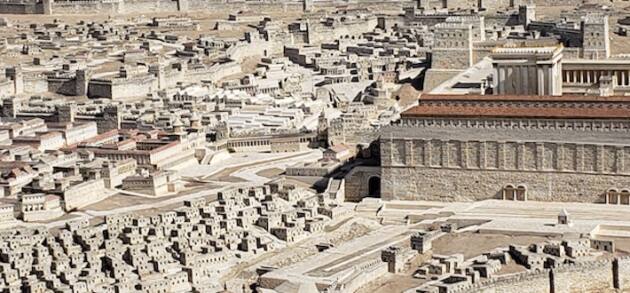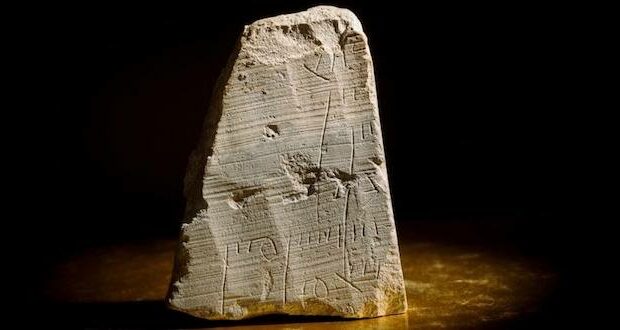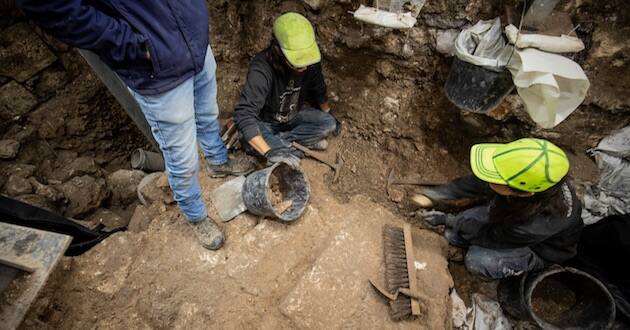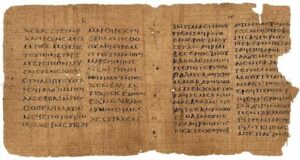Losing track of receipts is nothing new. The Israel Antiquities Authority recently announced that a 2,000-year-old receipt was discovered along the City of David’s Pilgrimage Road in Jerusalem. The road, which is currently underground, leads from the city gate and the Pool of Siloam to the Temple Mount and was a main thoroughfare.
A small fragment of a stone tablet was found with the name “Shimon” inscribed in Hebrew, accompanied by lines of letters and numbers suggesting a financial record was taken and indicating that money was involved in a transaction. Some of the numbers are preceded by their economic value, marked with another mem, an abbreviation of ma’ot (Hebrew for “money”), or with the letter resh, an abbreviation of reva’im (Hebrew for “quarters”).
“At first glance, the names and numbers may not seem exciting, but to think that, just like today, receipts were also used in the past for commercial purposes, and that such a receipt has reached us is a rare and gratifying find that allows a glimpse into everyday life in the holy city of Jerusalem,” the authority said. “The everyday life of the inhabitants of Jerusalem who resided here 2,000 years ago is expressed in this simple object.”
Four other similar Hebrew inscriptions dating to the early Roman period, the era also known as the time of Jesus, also have been found in Jerusalem and Bet Shemesh, according to Excavation Director Nahshon Szanton and Esther Eshel, an epigraphist and a professor with Bar-Ilan University. But the most recent discovery is the first of its kind to have been found from this historic period within boundaries of the city of Jerusalem.
According to researchers, the inscription was carved using a sharp tool on a chalkstone slab, which traditionally was used as an ossuary or burial chest in Jerusalem and Judea between 37 B.C. to 70 A.D. “Ossuaries are generally found in graves outside the city, but their presence has also been documented inside the city, perhaps as a commodity sold in a local artisan’s workshop or store,” authorities said.
READ: More amazing discoveries from the City of David
The historic receipt was found in the lower city along the Pilgrimage Road, roughly one-third of a mile in length and connecting the city gate from the south of the City of David to the Temple Mount.
“The combination of the architectural and tangible space of the huge, paved stones of the square that were preserved at the site and the discovery of small finds in this area, such as the measuring table and the new inscription, allow us to reconstruct parts of the incredibly unique archeological puzzle in one of the vibrant centers that existed in ancient Jerusalem,” Szanton and Eshel said in a joint statement. “Each piece of information, and certainly an ancient inscription, adds a new and fascinating dimension to the history of the city.”
Amazingly, the find had gone unnoticed by previous archaeologists, most likely because of antiquated techniques.

A scale model of Jerusalem from the time of Christ. The Pilgrim Path is bottom left. Photo: Dwight Widaman.
Nineteenth-century archaeology was built around digging lots of trenches that were just a few feet deep and wide then dumping the dirt from one trench into another.
“So they left a lot of material behind,” says Nahshon Szanton, the Antiquities Authority excavations director. “They basically left behind everything other than intact, remarkable pieces, some of which they took and some of which they published.”
Archaeologists only noticed it because they cleaned the stone slab, a standard practice in digs today which results in many new finds.
Eli Escusido, Director of the Israel Antiquities Authority, commented on the discovery, saying that “the Pilgrimage Road, which is continually being uncovered in the City of David National Park in Jerusalem, is a flagship project of the Israel Antiquities Authority. It is not a coincidence that the many discoveries which are being revealed in the excavation shed light on the centrality of this road even during the Second Temple period. With every discovery, our understanding of the area deepens, revealing this street’s pivotal role in the daily lives of Jerusalem’s inhabitants 2,000 years ago”.
–Dwight Widaman | Metro Voice
 Metro Voice News Celebrating Faith, Family & Community
Metro Voice News Celebrating Faith, Family & Community 









